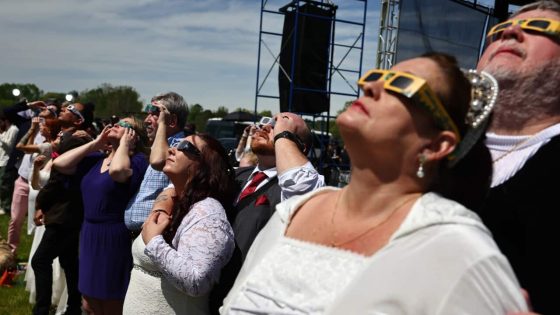Key Points
- Eclipse mania has taken hold of the United States, with millions travelling to witness a total solar eclipse.
- The city of Mazatlan in Mexico was the first major viewing spot for the celestial phenomenon.
- The next total solar eclipse over Australia will be visible from four states.
Viewers along the eclipse’s direct path were treated to the rare spectacle of the moon appearing as a dark orb creeping in front of the sun, briefly blocking out all but a brilliant halo of light around the sun’s outer edge.
Health professionals urged people to use certified eclipse glasses to prevent permanent retinal injury. Source: EPA / Peter Foley
At least 32 million Americans reside along the eclipse’s “path of totality”, which started in Mexico and stretches across portions of 13 US states, from Texas to Maine.

Hotels and short-term rentals in prime viewing locations were booked solid for months in advance across states including Texas, Arkansas, Ohio and Maine. Source: AAP / Robert F. Bukaty/AP
Before the event, officials predicted another five million would travel to witness the event.
The crowds burst into cheers and applause as the eclipse reached totality.

Mexico’s Mazatlan was the first major viewing spot for totality. An orchestra played the “Star Wars” movie theme as skies darkened under the approaching lunar shadow. Source: AP / Fernando Llano
The period of totality, lasting up to four-and-a-half minutes depending on the observer’s location, was ushered in by other eerie eclipse effects.
A partial eclipse, in which the moon obscures only a portion of the sun, was unfolding across most of the continental United States.

A helicopter flies across the sky during the solar eclipse in New York. Source: Getty / Gotham
Eclipse hysteria prompted celebrations, with concerts, festivals, and viewing parties held all over the US.
At least two weddings and one marriage proposal were known to have taken place among roughly 2,000 people who assembled at Niagara Falls State Park, despite overcast skies.

A couple kiss during a mass wedding at the Total Eclipse of the Heart solar eclipse festival in Russellville, Arkansas. Source: Getty / Mario Tama
The event prompted a surge in accommodation bookings, with Airbnb noting in February that it had seen a 1,000 per cent increase in searches for short-term stays.
The eclipse pathline was also clear on a map showing Airbnb occupancy rates, which jumped to 100 per cent for the night of 7 April, according to data from short-term rental analytics company AirDNA.
What is a total solar eclipse?
NASA explains a solar eclipse occurs when “the Moon passes between the Sun and the Earth, with the Moon casting its shadow” on Earth.

The total solar eclipse was viewed by millions of people on its path from Mexico to Maine. Source: AAP / Jeff Roberson/AP
As the sky gets dark, viewers on the ground catch a glimpse of the sun’s corona (its outer atmosphere), which is otherwise obstructed by the bright sun.
Due to the totality of the sun’s coverage, it is the only time you can directly look at the sun with the naked eye without damaging your retinas.
Some US locations witnessed the moon cover the sun for seconds while those best placed had up to 4 minutes. Viewers outside the path of totality see a partial solar eclipse.
When is Australia’s next total solar eclipse?
– With AAP, Reuters and Agence France-Presse
Source Agencies



